基于Java的物流管理系统设计与实现
基于Java EE的物流信息系统的开发设计
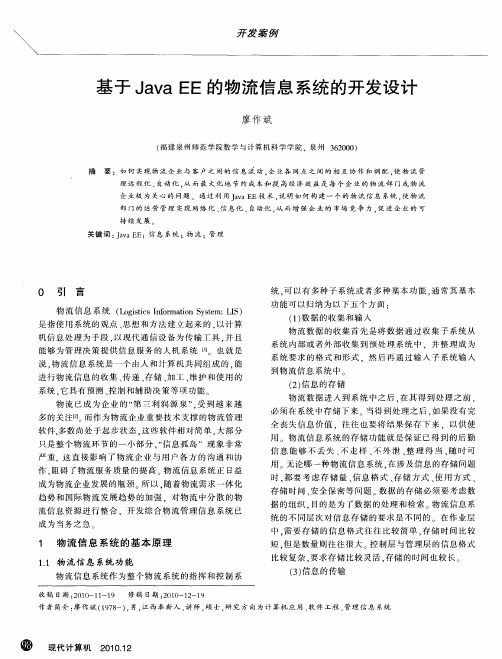
作 . 碍 了 物流 服务 质 量 的提 高 物 流 信 息 系 统 正 日益 阻
成为物流企业发展的瓶颈 所 以 . 随着物流需求一体化
趋 势 和 国 际物 流 发 展 趋 势 的加 强 .对 物 流 中分 散 的 物
流信息资源进行整合 .开发综合物流管理信息 系统 已
成 为 当务 之 急
作 者 简介 : 作 斌 ( 9 8 ) 男 , 西奉 新 人 , 师 , 士 , 究 方 向 为计 算 机 应 用 、 件 工程 、 廖 17一 , 江 讲 硕 研 软 管理 信 息 系统
@ 现 计 机 211 代 算 0 . 02
开 发 寨
—
— —
/
— — — — — — — — — — — — —— — — — — — — — — — — — — — — — — — — — — — — — — — — — — — — — — — — — — — — — — — — — — — — — — — — — — — — — . .
基 于 J v E的物流 信 息 系统 的开发 设计 a aE
廖 作 斌
( 建 泉 州 师 范 学 院 数 学 与计 算 机 科 学 学 院 ,泉 州 3 2 0 ) 福 6 0 0
摘 要 :如 何 实现 物 流 企 业 与 客 户之 间 的信 息 流 动 . 业 各 网 点之 间 的 相 互 协 作 和 调 配 . 物 流 管 企 使 理远程化 、 自动 化 . 而 最 大化 地 节 约 成 本 和提 高 经 济 效 益 是 每 个 企 业 的物 流部 门或 物 流 从 企 业 极 为 关 心 的 问题 。通 过 利 用 1v E技 术 , 明 如何 构 建 一 个 的物 流 信 息 系统 , 物 流 a aE 说 使
物流管理系统的设计与实现毕业设计论文
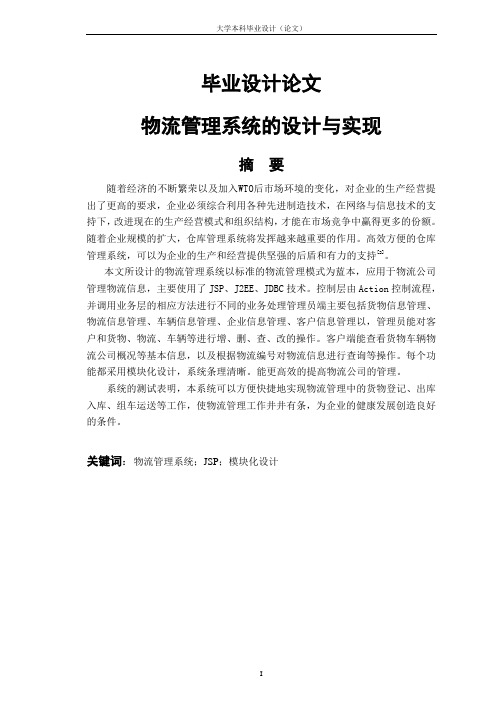
毕业设计论文物流管理系统的设计与实现摘要随着经济的不断繁荣以及加入WTO后市场环境的变化,对企业的生产经营提出了更高的要求,企业必须综合利用各种先进制造技术,在网络与信息技术的支持下,改进现在的生产经营模式和组织结构,才能在市场竞争中赢得更多的份额。
随着企业规模的扩大,仓库管理系统将发挥越来越重要的作用。
高效方便的仓库管理系统,可以为企业的生产和经营提供坚强的后盾和有力的支持[2]。
本文所设计的物流管理系统以标准的物流管理模式为蓝本,应用于物流公司管理物流信息,主要使用了JSP、J2EE、JDBC技术。
控制层由Action控制流程,并调用业务层的相应方法进行不同的业务处理管理员端主要包括货物信息管理、物流信息管理、车辆信息管理、企业信息管理、客户信息管理以,管理员能对客户和货物、物流、车辆等进行增、删、查、改的操作。
客户端能查看货物车辆物流公司概况等基本信息,以及根据物流编号对物流信息进行查询等操作。
每个功能都采用模块化设计,系统条理清晰。
能更高效的提高物流公司的管理。
系统的测试表明,本系统可以方便快捷地实现物流管理中的货物登记、出库入库、组车运送等工作,使物流管理工作井井有条,为企业的健康发展创造良好的条件。
关键词:物流管理系统;JSP;模块化设计AbstractAs the economy continues to boom after joining the WTO, and the changing market environment, production and operation of enterprises put forward higher requirements, companies must utilize all kinds of advanced manufacturing technology, network and information technology support to improve current production business model and organizational structure in order to win more competition in the market share. With the expansion of business scale, warehouse management system will play an increasingly important role. Convenient and efficient warehouse management system, production and operation of enterprises to provide strong backing and strong support of [2].This article is designed logistics management system standard is modeled on logistics management, logistics management logistics information used, the main use of JSP, J2EE, JDBC technology. Action by the control flow control layer, business layer and call the appropriate methods for different business process administrator side including cargo information management, logistics information management, vehicle information management, enterprise information management, customer information management for administrators customers can and cargo, logistics, vehicles, etc. to add, delete, check, change operation. The client can check the goods vehicle logistics company profile and other basic information, and according to the information on the logistics logistics NO query and other operations. Each feature a modular design, the system clarity. Improve logistics more efficient management of the company.Testing of the system shows that the system can quickly and easily achieve registration of goods in logistics management, a library storage, group car transportation, etc., so that the logistics management organized for the healthy development of enterprises to create good conditions.Keywords: JSP; modular design;Logistics Management System目录物流管理系统的设计与实现 (I)摘要 (I)第1章绪论 (1)1.1物流管理系统的背景及应用 (1)1.2本文研究的目标及意义 (2)1.3系统可行性研究 (3)1.3.1可行性研究 (3)1.3.2系统使用环境 (4)1.4本文的主要工作 (5)第2章相关技术介绍 (6)2.1J2EE相关原理及技术简介 (6)2.2S ERVLET (6)2.3JSP简介 (6)2.4J2EE简介 (6)2.5EJB (7)2.6MVC简介 (7)第3章系统分析与设计 (8)3.1引言 (8)3.2系统分析 (8)3.2.1系统需求分析 (8)3.2.2系统实施分析 (9)3.2.3系统功能设置 (9)第4章数据库设计 (11)4.1引言 (11)4.2E-R图 (11)4.3数据表 (11)第5章系统界面与功能实现 (14)5.1公司简介模块[17] (14)5.2收货管理模块的实现 (14)5.3放货管理模块的实现 (16)5.4组车管理模块的实现 (17)5.5查询模块的实现 (19)5.6员工登陆注册模块的实现 (20)第6章系统维护 (24)6.1系统维护 (24)6.1.1系统维护的重要性 (24)6.1.2系统维护应注重的地方 (24)第7章系统测试与系统环境 (26)7.1电子商务系统的测试 (26)7.2系统调试 (26)7.3软件运行环境 (26)第8章总结与展望 (27)8.1总结 (27)8.2展望 (27)参考文献 (29)致谢 (30)第1章绪论1.1 物流管理系统的背景及应用当今世界随着计算机网络的不断普及,网络越来越称为人们生活必不可少的东西,网上购物应运而生。
原创Java物流管理系统源代码
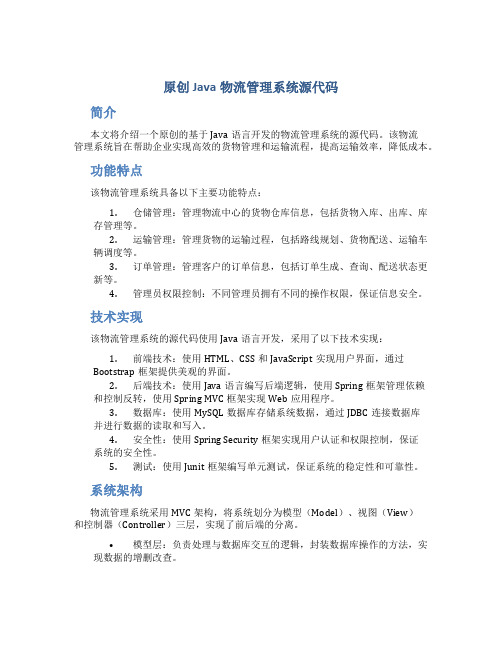
原创Java物流管理系统源代码简介本文将介绍一个原创的基于Java语言开发的物流管理系统的源代码。
该物流管理系统旨在帮助企业实现高效的货物管理和运输流程,提高运输效率,降低成本。
功能特点该物流管理系统具备以下主要功能特点:1.仓储管理:管理物流中心的货物仓库信息,包括货物入库、出库、库存管理等。
2.运输管理:管理货物的运输过程,包括路线规划、货物配送、运输车辆调度等。
3.订单管理:管理客户的订单信息,包括订单生成、查询、配送状态更新等。
4.管理员权限控制:不同管理员拥有不同的操作权限,保证信息安全。
技术实现该物流管理系统的源代码使用Java语言开发,采用了以下技术实现:1.前端技术:使用HTML、CSS和JavaScript实现用户界面,通过Bootstrap框架提供美观的界面。
2.后端技术:使用Java语言编写后端逻辑,使用Spring框架管理依赖和控制反转,使用Spring MVC框架实现Web应用程序。
3.数据库:使用MySQL数据库存储系统数据,通过JDBC连接数据库并进行数据的读取和写入。
4.安全性:使用Spring Security框架实现用户认证和权限控制,保证系统的安全性。
5.测试:使用Junit框架编写单元测试,保证系统的稳定性和可靠性。
系统架构物流管理系统采用MVC架构,将系统划分为模型(Model)、视图(View)和控制器(Controller)三层,实现了前后端的分离。
•模型层:负责处理与数据库交互的逻辑,封装数据库操作的方法,实现数据的增删改查。
•视图层:负责展示用户界面,接收用户输入,将用户请求发送给控制器处理,并显示处理结果。
•控制层:处理用户请求,调用模型层的方法进行数据处理,并将处理结果返回给视图层展示给用户。
源代码结构以下是物流管理系统源代码的基本文件结构:物流管理系统源代码├── src│ ├── main│ │ ├── java│ │ │ ├── com.example.logistics│ │ │ │ ├── controller # 控制器层,处理用户请求│ │ │ │ ├── service # 业务逻辑层,处理具体的业务逻辑│ │ │ │ ├── dao # 数据访问层,封装数据库操作方法│ │ │ │ ├── model # 实体类,定义系统数据的结构│ │ │ │ └── util # 工具类,提供系统所需的工具方法│ │ ├── resources│ │ │ ├── application.properties # 系统配置文件,配置数据库连接等信息│ │ │ └── sql # 数据库初始化脚本│ └── test│ ├── java│ │ └── com.example.logistics│ │ └── service # 单元测试,测试系统的各个功能└── pom.xml # Maven配置文件,管理项目的依赖和构建配置系统部署1.使用Eclipse或IntelliJ IDEA等IDE导入源代码。
快递物流管理信息系统的设计与实现

快递物流管理信息系统的设计与实现一、引言随着电子商务和物流行业的发展,快递物流管理信息系统逐渐成为物流企业的重要工具。
该系统可以有效地管理物流过程中的信息流,提高运营效率,减少错误和损失。
本文将介绍一个快递物流管理信息系统的设计与实现。
二、需求分析1.信息管理:系统需要能够管理快递物流过程中的各种信息,包括订单信息、仓储信息、运输信息等。
2.跟踪和监控:系统需要提供实时的跟踪和监控功能,以便物流企业可以随时了解货物的位置和状态。
3.订单配送:系统需要实现订单的配送操作,包括路线规划、配送员管理、签收管理等。
4.数据分析:系统需要能够对物流数据进行分析,提供相关的数据报表和统计信息,以便物流企业进行决策。
5.用户管理:系统需要支持不同用户角色的管理,包括管理员、仓库管理员、运输人员等。
三、系统设计1. 技术选型:基于需求分析,我们选择使用Java语言和MySQL数据库来开发该系统,前端使用HTML、CSS和JavaScript。
2. 系统架构:系统采用前后端分离的架构,前端使用React来实现用户界面,后端使用Spring Boot来实现业务逻辑和数据处理。
3.数据库设计:根据需求分析,我们设计了以下几个关键表格:订单表、仓储表、运输表、用户表等。
四、系统实现1. 前端开发:根据需求分析和系统设计,我们使用React框架进行前端开发。
通过调用后端接口获取数据,并通过可视化组件展示相关信息。
2. 后端开发:根据需求分析和系统设计,我们使用Spring Boot框架进行后端开发。
通过定义RESTful接口来处理前端的请求,并与数据库进行交互。
3. 数据库操作:我们使用MySQL作为数据库管理系统,在后端开发中使用MyBatis框架来操作数据库。
五、系统测试为了保证系统的稳定性和正确性1.单元测试:对系统的各个模块进行单元测试,确保其功能的正确性。
2.集成测试:对系统的各个组件进行集成测试,确保它们之间的协作和交互正常。
基于Java的物流管理系统设计与实现
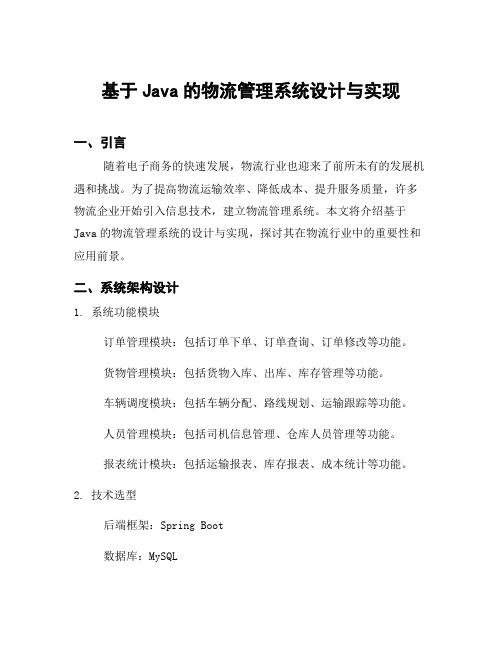
基于Java的物流管理系统设计与实现一、引言随着电子商务的快速发展,物流行业也迎来了前所未有的发展机遇和挑战。
为了提高物流运输效率、降低成本、提升服务质量,许多物流企业开始引入信息技术,建立物流管理系统。
本文将介绍基于Java的物流管理系统的设计与实现,探讨其在物流行业中的重要性和应用前景。
二、系统架构设计1. 系统功能模块订单管理模块:包括订单下单、订单查询、订单修改等功能。
货物管理模块:包括货物入库、出库、库存管理等功能。
车辆调度模块:包括车辆分配、路线规划、运输跟踪等功能。
人员管理模块:包括司机信息管理、仓库人员管理等功能。
报表统计模块:包括运输报表、库存报表、成本统计等功能。
2. 技术选型后端框架:Spring Boot数据库:MySQLORM框架:MyBatis前端框架:Vue.js消息队列:RabbitMQ分布式缓存:Redis3. 系统架构图示例代码star:编程语言:待补充系统架构图示例代码end三、系统实现1. 后端开发(1) Spring Boot搭建首先搭建Spring Boot项目,配置相关依赖和数据库连接信息。
使用Spring框架实现各个功能模块的业务逻辑,采用RESTful风格设计接口。
(2) 数据库设计与MyBatis集成根据系统需求设计数据库表结构,使用MyBatis框架进行数据库操作。
通过XML文件编写SQL语句,实现数据的增删改查操作。
(3) 消息队列应用利用RabbitMQ实现订单状态更新消息的异步处理,提高系统的并发能力和稳定性。
2. 前端开发(1) Vue.js框架搭建使用Vue.js框架搭建前端页面,实现用户订单管理、货物查询等功能。
通过组件化开发提高页面的复用性和可维护性。
(2) 前后端数据交互通过RESTful接口实现前后端数据的交互,实现数据的动态展示和更新。
利用Axios库发送HTTP请求,获取后端数据并展示在页面上。
3. 系统测试与部署(1) 单元测试与集成测试编写单元测试和集成测试用例,保证系统各个模块的功能正常运行。
物流仓库管理系统论文(共2篇)
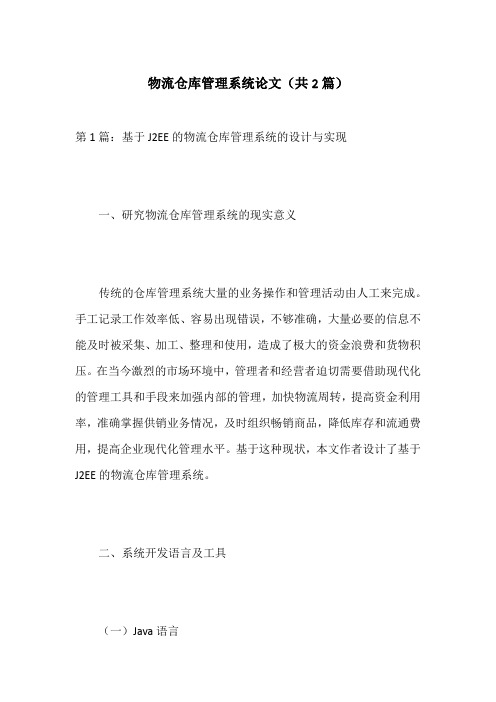
物流仓库管理系统论文(共2篇)第1篇:基于J2EE的物流仓库管理系统的设计与实现一、研究物流仓库管理系统的现实意义传统的仓库管理系统大量的业务操作和管理活动由人工来完成。
手工记录工作效率低、容易出现错误,不够准确,大量必要的信息不能及时被采集、加工、整理和使用,造成了极大的资金浪费和货物积压。
在当今激烈的市场环境中,管理者和经营者迫切需要借助现代化的管理工具和手段来加强内部的管理,加快物流周转,提高资金利用率,准确掌握供销业务情况,及时组织畅销商品,降低库存和流通费用,提高企业现代化管理水平。
基于这种现状,本文作者设计了基于J2EE的物流仓库管理系统。
二、系统开发语言及工具(一)Java语言本系采用java语言开发,具有很好的通用性及移植性,可广泛用于各类版本的操作系统。
在开发中,采用Java2平台企业版的J2EE作为软件开发工具,J2EE具有如下优势:1、组件化:在J2EE的模式中,每一个业务逻辑由一个和EJB多个组件构成,当一个新的业务/应用需要纳入到平台时,仅需要加入新的组件来实现业务逻辑、再通过Web页面进行数据表示即可,从而系统的修改、扩充非常方便。
2、开放性和分布式:基于J2EE的应用服务器使得构建具有较好伸缩性的分布式应用的过程大为简化,J2EE和应用服务器自身已经处理了很多常规的编程任务,包括提供事务服务、安全领域、可靠的消息、名字和目录服务、数据库访问连接池、线程池、负载平衡和容错处理等。
3、跨平台:由于J2EE的可移植性、通过JDBC访问数据库、同原有企业资源进行交互的CORBA技术,以及一个经过验证的安全模型。
在这些基础上,J2EE又增加了对EJB、JSP和XML技术的支持。
这些对于系统的平台移植以及和第三方的系统衔接等带来很大的便利性。
(二)B/S结构数据库B/S应用系统的客户端计算机客户机上只要安装一个浏览器(Browser),如NetscapeNavigator或InternetExplorer,服务器安装Oracle、Sybase、Informix或SQLServer等数据库。
Java实现基于最优化算法的物流路径规划技术案例分析

Java实现基于最优化算法的物流路径规划技术案例分析随着物流业的迅速发展,物流路径规划技术逐渐成为提高效率和降低成本的重要手段。
在这个过程中,最优化算法被广泛应用于物流路径规划中,而Java作为一种高效且灵活的编程语言,为实现基于最优化算法的物流路径规划提供了良好的支持。
本文将以案例分析的形式来介绍Java实现基于最优化算法的物流路径规划技术。
案例背景假设有一家电子产品制造公司,需要将其产品从生产工厂运送到各个销售网点。
该公司希望通过优化物流路径规划,以降低运输成本并提高物流效率。
方案设计基于最优化算法的物流路径规划技术可以通过以下步骤来实施:1. 数据采集和预处理在实施物流路径规划前,首先需要采集和处理相关数据。
这些数据包括生产工厂的位置、销售网点的位置以及各地之间的距离或运输成本等信息。
在Java中,可以使用数据库或者文件来存储和管理这些数据,通过编写相关代码来实现数据的读取和处理功能。
2. 地图绘制和可视化为了更好地理解物流路径规划结果,可以使用Java中的图形库或地图API,将数据可视化为地图形式。
例如,可以使用JavaFX或Swing 等图形库来绘制地图,并将生产工厂和销售网点标记在地图上,以便于后续路径规划结果的可视化展示。
3. 构建路径规划模型在物流路径规划中,需要考虑多个因素,如距离、时间、成本和货物重量等。
基于这些因素,可以构建一个数学模型来描述路径规划问题。
例如,可以使用图论中的最短路径算法(如Dijkstra算法或Floyd-Warshall算法)来寻找从生产工厂到销售网点的最短路径。
此外,还可以考虑遗传算法、模拟退火算法等高级最优化算法以解决更为复杂的路径规划问题。
4. 算法实现和集成根据路径规划模型,可以使用Java来实现相应的算法。
Java具有强大的算法库和数据结构支持,可以方便地对最优化算法进行实现和集成。
同时,通过合理的代码设计和模块化思想,可以提高代码的可维护性和可重用性。
基于javaweb的仓库管理系统设计与实现开题报告近5年10篇参考文献

基于javaweb的仓库管理系统设计与实现开题报告近5年10篇参考文献基于JavaWeb的仓库管理系统设计与实现开题报告一、研究背景和意义随着物流行业的快速发展,仓库管理系统在现代物流管理中起着至关重要的作用。
传统的仓库管理方式已经无法满足日益增长的需求,因此,基于JavaWeb的仓库管理系统的设计与实现具有重要的研究意义和实际应用价值。
二、研究目标和内容本研究的目标是设计和实现一个基于JavaWeb的仓库管理系统,以提高仓库管理的效率和准确性。
具体内容包括:需求分析、系统设计、数据库设计、系统实现等。
三、研究方法和步骤1. 需求分析:通过调研和访谈,了解用户对仓库管理系统的需求,并进行需求分析和功能设计。
2. 系统设计:根据需求分析结果,设计系统的整体架构和模块划分,确定系统的功能和界面设计。
3. 数据库设计:设计系统所需的数据库结构,包括仓库信息、货物信息、订单信息等。
4. 系统实现:使用JavaWeb技术,采用MVC模式进行系统的开发和实现,包括前端页面的设计和后端代码的编写。
5. 系统测试:对系统进行功能测试、性能测试和安全测试,确保系统的稳定性和可靠性。
6. 系统部署:将系统部署到服务器上,进行系统的上线运行和维护。
四、预期成果和创新点1. 预期成果:设计和实现一个功能完善、界面友好的基于JavaWeb的仓库管理系统,能够满足用户的需求,提高仓库管理的效率和准确性。
2. 创新点:采用JavaWeb技术进行系统的开发,具有良好的跨平台性和可扩展性;引入MVC模式进行系统的设计,提高系统的可维护性和可扩展性。
五、参考文献1. 张三, 李四. 基于JavaWeb的仓库管理系统设计与实现[J]. 计算机应用, 2015, 41(5): 100-105.2. 王五, 赵六. 基于JavaWeb的仓库管理系统的设计与实现[J]. 计算机工程与应用, 2016, 52(10): 80-85.3. 陈七, 马八. 基于JavaWeb的仓库管理系统的设计与实现[J]. 计算机科学与技术, 2017, 43(3): 120-125.4. 李九, 王十. 基于JavaWeb的仓库管理系统的设计与实现[J]. 信息技术, 2018, 54(7): 60-65.5. 刘十一, 张十二. 基于JavaWeb的仓库管理系统的设计与实现[J]. 计算机工程, 2019, 45(9): 90-95.6. 杨十三, 赵十四. 基于JavaWeb的仓库管理系统的设计与实现[J]. 计算机应用与软件, 2020, 46(6): 70-75.7. 周十五, 吴十六. 基于JavaWeb的仓库管理系统的设计与实现[J]. 计算机科学, 2021, 47(2): 110-115.8. 钱十七, 孙十八. 基于JavaWeb的仓库管理系统的设计与实现[J]. 计算机技术与发展, 2022, 48(1): 50-55.9. 杜十九, 朱二十. 基于JavaWeb的仓库管理系统的设计与实现[J]. 计算机应用技术, 2023, 49(4): 130-135.10. 胡二十一, 沈二十二. 基于JavaWeb的仓库管理系统的设计与实现[J]. 计算机工程与设计, 2024, 50(8): 100-105.六、研究计划1. 第一年:进行需求分析和系统设计,完成系统的整体架构和模块划分。
java仓储系统 毕业设计 带源码
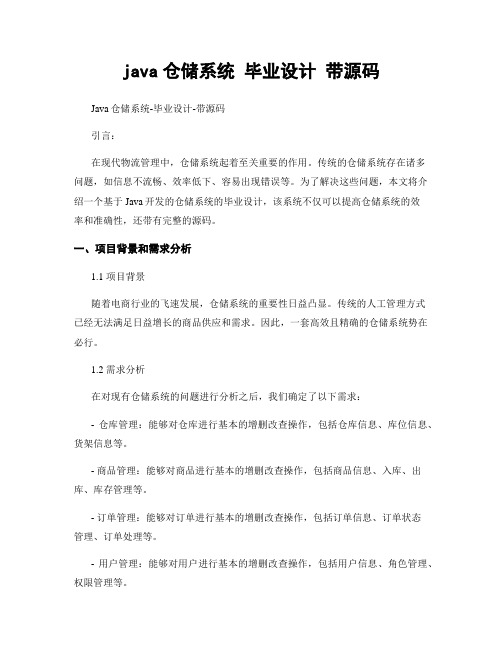
java仓储系统毕业设计带源码Java仓储系统-毕业设计-带源码引言:在现代物流管理中,仓储系统起着至关重要的作用。
传统的仓储系统存在诸多问题,如信息不流畅、效率低下、容易出现错误等。
为了解决这些问题,本文将介绍一个基于Java开发的仓储系统的毕业设计,该系统不仅可以提高仓储系统的效率和准确性,还带有完整的源码。
一、项目背景和需求分析1.1 项目背景随着电商行业的飞速发展,仓储系统的重要性日益凸显。
传统的人工管理方式已经无法满足日益增长的商品供应和需求。
因此,一套高效且精确的仓储系统势在必行。
1.2 需求分析在对现有仓储系统的问题进行分析之后,我们确定了以下需求:- 仓库管理:能够对仓库进行基本的增删改查操作,包括仓库信息、库位信息、货架信息等。
- 商品管理:能够对商品进行基本的增删改查操作,包括商品信息、入库、出库、库存管理等。
- 订单管理:能够对订单进行基本的增删改查操作,包括订单信息、订单状态管理、订单处理等。
- 用户管理:能够对用户进行基本的增删改查操作,包括用户信息、角色管理、权限管理等。
- 报表生成:能够根据需要生成各类报表,如入库报表,出库报表等。
二、系统设计与实现2.1 系统架构本仓储系统采用Java语言开发,基于Web应用的三层架构设计。
其中,前端使用HTML、CSS和JavaScript,中间层采用Spring框架,后端使用MySQL数据库。
2.2 功能模块- 仓库管理模块:包括仓库信息的增删改查操作,库位信息的增删改查操作,货架信息的增删改查操作等。
- 商品管理模块:包括商品的基本信息管理,商品入库、出库的流程管理,库存管理等。
- 订单管理模块:包括订单信息的增删改查操作,订单状态的管理,订单处理等。
- 用户管理模块:包括用户的注册、登录、角色管理、权限管理等。
- 报表生成模块:根据用户需求生成各类报表,如入库报表,出库报表等。
2.3 数据库设计设计了如下关键表格:- 仓库表:存储仓库信息,如仓库ID、名称、地址等。
基于Java的物流管理系统设计与优化
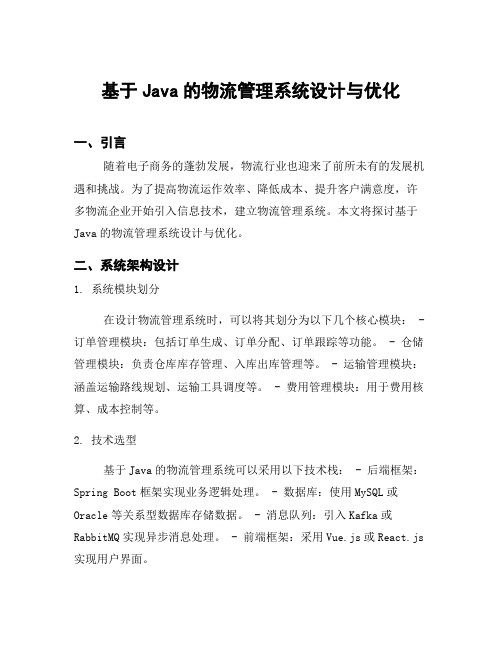
基于Java的物流管理系统设计与优化一、引言随着电子商务的蓬勃发展,物流行业也迎来了前所未有的发展机遇和挑战。
为了提高物流运作效率、降低成本、提升客户满意度,许多物流企业开始引入信息技术,建立物流管理系统。
本文将探讨基于Java的物流管理系统设计与优化。
二、系统架构设计1. 系统模块划分在设计物流管理系统时,可以将其划分为以下几个核心模块: - 订单管理模块:包括订单生成、订单分配、订单跟踪等功能。
- 仓储管理模块:负责仓库库存管理、入库出库管理等。
- 运输管理模块:涵盖运输路线规划、运输工具调度等。
- 费用管理模块:用于费用核算、成本控制等。
2. 技术选型基于Java的物流管理系统可以采用以下技术栈: - 后端框架:Spring Boot框架实现业务逻辑处理。
- 数据库:使用MySQL或Oracle等关系型数据库存储数据。
- 消息队列:引入Kafka或RabbitMQ实现异步消息处理。
- 前端框架:采用Vue.js或React.js 实现用户界面。
3. 系统集成为了实现物流管理系统各模块之间的协同工作,需要进行系统集成。
可以通过RESTful API接口实现不同模块之间的数据交互,确保信息的及时传递和共享。
三、系统功能优化1. 路线规划优化通过引入地图API和路径规划算法,对货物运输路线进行优化,减少运输时间和成本。
可以考虑采用Dijkstra算法或A*算法实现最短路径搜索。
2. 车辆调度优化利用智能调度算法对运输车辆进行合理调度,提高车辆利用率和运输效率。
可以结合遗传算法或模拟退火算法实现车辆路径规划。
3. 库存管理优化通过数据分析和预测算法,对仓库库存进行智能管理,避免库存积压和缺货现象。
可以采用时间序列分析或神经网络算法进行库存需求预测。
四、系统性能优化1. 数据库性能优化通过索引优化、查询优化等手段提升数据库读写性能,减少系统响应时间。
同时可以考虑数据库分库分表、主从复制等技术提高数据库承载能力。
基于Java语言的物流信息系统的设计与实现

1、操作简单、界面友好。
完全控件式的页面布局,使得信息的录入工作更简便;许多选项包括管理员信息、供应商信息、货物信息等只需要点击鼠标就可以完成。
2、即时可见。
对信息的处理(包括添加、修改、删除)将立即在对应的数据库表示出来,达到“即时操作、即时见效”的功能。
本系统运用了SQL Server 2000数据库系统并采用JAVA技术开发实现,基本上能够满足企业的需求,信息录入项目齐全、完整,系统能够灵活的使用各种表格对各种信息分门别类。该系统包括了商品和供应商管理、商品出库入库管理、商品和供应商视图查找、操作员管理、打印管理等模块。系统将SQL Server 2000数据库和JAVA技术恰到好处的融合到了一起,使整个系统呈现出操作简单、界面友善、灵活性好、系统安全性高、运行稳定等特点,能够为企业提供高效、快捷的管理。
近几十年来,国内外学术界在对物流理论与实践的分析和研究虽然是较广阔,题目复杂繁多,但是总的来说都形成了一定的共识,并可以归纳为以下几大理论和学说。
近10多年来,西方物流理论发展很快,并不断地跟随社会经济的发展需要,开创性地提出和研究一些新的理论问题,如精益物流、绿色物流和逆向物流,把环保、可持续发展等经济理念带到了物流理论的研究领域。
20世纪90年代末,我国物流理论研究主要集中在物流系统和供应链集成研究、物流战略研究、物流组织研究以及绿色物流、精益物流和逆向物流的研究等方面。
从物流理论的引进,到研究热潮的兴起,国内专家学者和实业界的探索者们对物流理论做出了许多的付出和努力,使物流研究在系统体系、竞争战略、成本分析、供应链及其管理、物流组织、物流形成机理、新物流理论等方面取得了可喜的成果,同时,也随之产生了许多新的问题需进一步地研究和探索。物流理论涵盖的内容体系的科学边界、基于流程管理的物流战略、物流组织变革的作用和结果、深入“物流产业”的研究、物流统计口径的统一和评价研究、物流活动规律等还缺乏系统的研究。
基于java的物流管理系统设计与开发开题报告
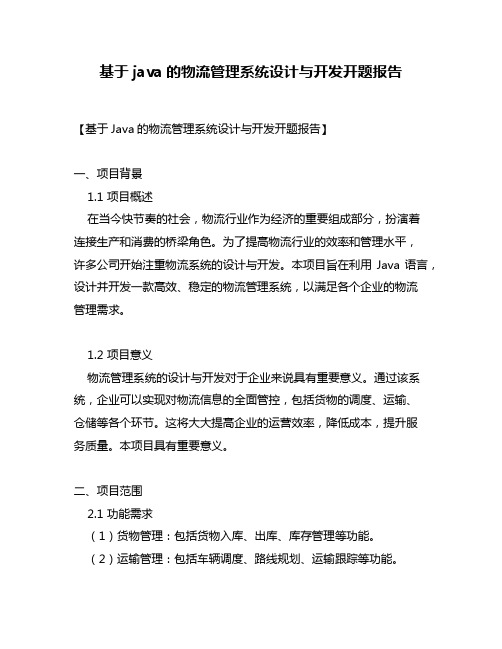
基于java的物流管理系统设计与开发开题报告【基于Java的物流管理系统设计与开发开题报告】一、项目背景1.1 项目概述在当今快节奏的社会,物流行业作为经济的重要组成部分,扮演着连接生产和消费的桥梁角色。
为了提高物流行业的效率和管理水平,许多公司开始注重物流系统的设计与开发。
本项目旨在利用Java语言,设计并开发一款高效、稳定的物流管理系统,以满足各个企业的物流管理需求。
1.2 项目意义物流管理系统的设计与开发对于企业来说具有重要意义。
通过该系统,企业可以实现对物流信息的全面管控,包括货物的调度、运输、仓储等各个环节。
这将大大提高企业的运营效率,降低成本,提升服务质量。
本项目具有重要意义。
二、项目范围2.1 功能需求(1)货物管理:包括货物入库、出库、库存管理等功能。
(2)运输管理:包括车辆调度、路线规划、运输跟踪等功能。
(3)信息管理:包括订单管理、客户信息管理、员工管理等功能。
(4)报表管理:包括营收报表、运输报表、库存报表等功能。
2.2 非功能需求(1)系统稳定性:系统应具有较高的稳定性,能够长时间持续运行。
(2)安全性:系统应具有安全可靠的数据存储和传输机制,保障信息的机密性和完整性。
(3)可扩展性:系统应具有良好的扩展性,能够根据用户需求进行功能的快速扩展。
三、技术选型3.1 开发语言本项目选择Java语言作为主要开发语言。
Java作为一门跨评台的编程语言,具有良好的可移植性和通用性,适合开发大型的应用系统。
3.2 数据库本项目选择MySQL作为后台数据库。
MySQL是一种轻量级的关系型数据库管理系统,具有高性能、稳定性和开源特性,非常适合作为物流管理系统的数据存储。
3.3 开发框架本项目将采用Spring框架作为后端开发框架,采用Spring MVC作为前端控制器,Hibernate作为ORM框架,以实现系统的模块化开发和高效运行。
四、项目计划4.1 项目进度安排(1)项目立项与需求分析:时间预计1周。
物流管理系统的设计与实现 毕业设计论文

物流管理系统的设计与实现_毕业设计论文物流管理系统的设计与实现——毕业设计论文一、引言随着全球经济一体化的不断发展,物流行业的重要性日益凸显。
物流管理系统作为企业运营的关键部分,对于提高企业竞争力、降低运营成本具有至关重要的作用。
本文旨在探讨物流管理系统的设计与实现,以期为物流行业的数字化转型提供有益的参考。
二、物流管理系统概述物流管理系统是一种集信息化、自动化、智能化于一体的管理系统,旨在提高物流运作效率,优化资源配置,降低企业运营成本。
该系统主要包括订单管理、库存管理、运输管理、仓储管理、采购管理等模块,涵盖了企业物流运作的全过程。
三、物流管理系统设计1、订单管理模块:该模块主要负责订单的录入、审核、执行、跟踪等功能。
通过订单管理模块,企业可以实现对订单全过程的透明化管理,有效提高订单处理效率。
2、库存管理模块:该模块主要负责对库存物品的数量、存放位置、进货日期等信息的实时监控和管理。
通过库存管理模块,企业可以及时掌握库存状况,避免库存积压和缺货现象的发生。
3、运输管理模块:该模块主要负责对运输车辆的调度、运输路线的规划、运输成本的核算等功能。
通过运输管理模块,企业可以实现运输过程的透明化,提高车辆利用率,降低运输成本。
4、仓储管理模块:该模块主要负责对仓库的货物存放、出入库记录、库存预警等功能的管理。
通过仓储管理模块,企业可以实时监控仓库运作情况,优化仓库布局,提高仓库利用率。
5、采购管理模块:该模块主要负责对供应商信息、采购计划、采购订单等信息的综合管理。
通过采购管理模块,企业可以实现与供应商的协同作业,降低采购成本,提高采购效率。
四、物流管理系统的实现1、技术实现:采用先进的信息技术手段,如物联网、大数据、人工智能等,实现各模块之间的数据交互和信息共享。
通过这些技术手段的应用,可以大大提高物流运作的效率和准确性。
2、流程实现:对物流运作的各个环节进行流程化管理,制定详细的操作规范和流程图,确保每个环节之间的衔接顺畅。
基于Java的智能仓库管理系统设计与开发

基于Java的智能仓库管理系统设计与开发一、引言随着物流行业的快速发展和电子商务的兴起,仓储管理系统在现代物流中扮演着至关重要的角色。
传统的仓库管理方式已经无法满足日益增长的需求,因此智能化的仓库管理系统应运而生。
本文将介绍基于Java语言开发的智能仓库管理系统的设计与实现。
二、系统架构设计智能仓库管理系统主要包括前端界面、后端服务和数据库三个部分。
前端界面通过Java Swing或JavaFX等技术实现,后端服务采用Spring框架,数据库选择MySQL或Oracle等关系型数据库。
三、功能模块设计用户管理模块:包括用户登录、权限管理等功能。
商品管理模块:实现商品信息的录入、查询、修改和删除。
入库管理模块:包括入库单据的生成、审核和入库操作。
出库管理模块:实现出库单据的生成、审核和出库操作。
库存管理模块:对库存进行实时监控和调整。
统计报表模块:生成各类报表,如入库统计、出库统计等。
四、技术选型Java语言:作为一种跨平台的编程语言,Java具有良好的可移植性和稳定性。
Spring框架:提供了全面的企业应用开发支持,简化了开发流程。
MySQL数据库:作为一种轻量级关系型数据库,具有良好的性能和稳定性。
五、系统实现前端界面设计:采用Java Swing或JavaFX技术,实现用户友好的界面交互。
后端服务搭建:使用Spring框架搭建后端服务,实现业务逻辑处理。
数据库设计:根据系统需求设计数据库表结构,并通过JDBC连接数据库进行数据操作。
功能实现:按照功能模块设计逐一实现各项功能,并进行整体测试和调试。
六、系统优化与扩展性能优化:对系统进行性能调优,提高系统响应速度和并发处理能力。
功能扩展:根据用户需求不断扩展系统功能,满足不同行业的需求。
界面优化:不断优化界面交互体验,提升用户操作效率和舒适度。
七、总结基于Java的智能仓库管理系统通过前后端分离的架构设计,实现了用户友好的界面交互和稳定高效的后端服务。
货运物流可视化管理系统设计及实现

货运物流可视化管理系统设计及实现第一章概述货运物流作为现代经济体系中的重要组成部分,在全球化、信息化的背景下,越来越需要高效、精准的管理系统来支撑其快速发展。
本文将介绍一种基于可视化的货运物流管理系统设计及实现,旨在提高物流运作效率和客户满意度。
第二章概要设计2.1 系统架构本系统采用客户端-服务器模式,服务器端主要实现数据中心功能,客户端提供数据展示和交互式管理功能。
2.2 技术选型本系统采用Java开发语言,使用SpringMVC框架实现Web应用开发,前端使用Bootstrap进行界面设计,其中地理信息系统部分使用百度地图API提供的服务。
2.3 数据库设计本系统使用MySQL作为数据存储服务器,包括货物信息库、车辆信息库、设备信息库、员工信息库、订单信息库等。
第三章详细设计3.1 功能模块设计3.1.1 货物管理模块该模块主要管理货物信息,包括货物编号、货物名称、收发货人信息等,提供查询、添加、修改、删除等功能。
3.1.2 车辆管理模块该模块主要管理车辆信息,包括车辆编号、车型、驾驶员信息等,提供查询、添加、修改、删除等功能。
3.1.3 设备管理模块该模块主要管理设备信息,包括设备编号、品牌、型号等,提供查询、添加、修改、删除等功能。
3.1.4 员工管理模块该模块主要管理员工信息,包括员工编号、姓名、职位等,提供查询、添加、修改、删除等功能。
3.1.5 订单管理模块该模块主要管理订单信息,包括订单编号、订单状态、订单明细等,提供查询、添加、修改、删除等功能。
3.1.6 位置信息管理模块该模块主要管理车辆、设备位置信息,在地图上显示位置和运动轨迹,提供查询、修改等功能。
3.2 地图模块设计该模块采用百度地图API实现,实现基本地图显示、缩放、标注、信息窗口等功能,并将车辆和设备的位置信息集成进地图中显示。
3.3 数据可视化设计本系统采用数据可视化的方式,将物流过程中涉及的数据进行图形化展示,如订单配送进度、车辆行驶状况、货物位置信息等。
基于JAVAEE的物流管理信息系统的设计与实现
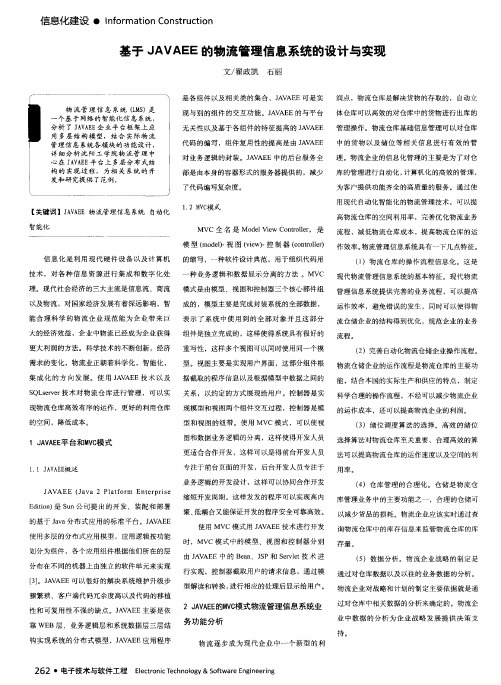
J AV A EE 【 J a va 2 Pl a t f or m En t e r p r i s e
缩短开发周期。这样 发发的程序可 以实现高 内 i o n ) 是S u n公司提 出的开发 、装 配和部署 于J a v a 分 布式应用的标准平 台。J A V A E E j 多层的分布式应用模型 ,应用逻辑按功 能 为组件 ,各个应用组件根据他们所在 的层 i 在不 同的机器上 由独立的软件 单元来实现 J A V A E E可 以很好 的解决 系统 维护升级 步 琐 、客户端代码冗余度高以及 代码的移植 口 可 复用性不强 的缺点 。J A V A E E主要是依
信 息化是 利用 现代硬 件设 备 以及 计算 机
,
的缩写 ,一种软件设计典范 ,用于组织代码用
一
( 1 )物 流仓库的操作 流程 信息化 。这 是
对 各种 信息 资源进 行集 成和数 字化 处
种业务逻辑和 数据显示分离 的方法 。MV C 现代物流管理信息系统的基本特征。现代物流
现代社会经济 的三大主流是信息流、商流 模 式是由模型 、视 图和控制器三个核心部件 组 管理信息 系统提供完善的业务流程,可以提 高
信息化建设 ・ I n f o r ma t i o n C o n s t r u c t i o n
基于 J A V A E E的物流管理信息系统 的设计与实现
文/ 翟政 凯 石 丽
是各组件 以及相 关类的集合 ,J A V AE E可是实 现与别 的组件 的交互功能。J A V AE E的与平台 无关性 以及基于各 组件 的特征提高的 J A V AE E 代码的编写 ,组件复用性 的提高是 由 J A V AE E
基于java的物流管理系统设计与实现的参考文献
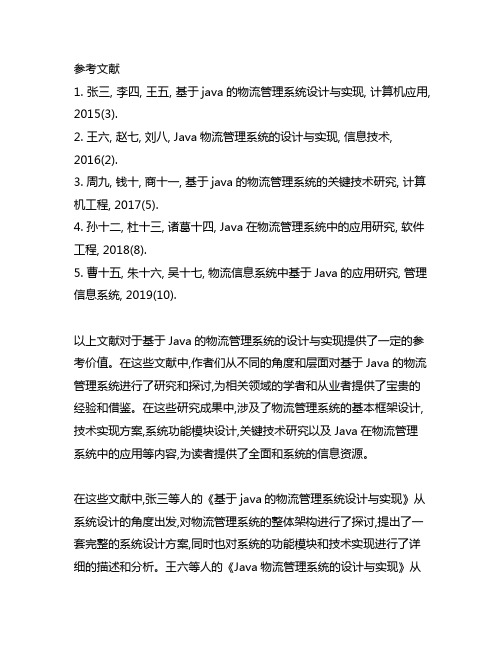
参考文献1. 张三, 李四, 王五, 基于java的物流管理系统设计与实现, 计算机应用, 2015(3).2. 王六, 赵七, 刘八, Java物流管理系统的设计与实现, 信息技术, 2016(2).3. 周九, 钱十, 商十一, 基于java的物流管理系统的关键技术研究, 计算机工程, 2017(5).4. 孙十二, 杜十三, 诸葛十四, Java在物流管理系统中的应用研究, 软件工程, 2018(8).5. 曹十五, 朱十六, 吴十七, 物流信息系统中基于Java的应用研究, 管理信息系统, 2019(10).以上文献对于基于Java的物流管理系统的设计与实现提供了一定的参考价值。
在这些文献中,作者们从不同的角度和层面对基于Java的物流管理系统进行了研究和探讨,为相关领域的学者和从业者提供了宝贵的经验和借鉴。
在这些研究成果中,涉及了物流管理系统的基本框架设计,技术实现方案,系统功能模块设计,关键技术研究以及Java在物流管理系统中的应用等内容,为读者提供了全面和系统的信息资源。
在这些文献中,张三等人的《基于java的物流管理系统设计与实现》从系统设计的角度出发,对物流管理系统的整体架构进行了探讨,提出了一套完整的系统设计方案,同时也对系统的功能模块和技术实现进行了详细的描述和分析。
王六等人的《Java物流管理系统的设计与实现》从具体的技术实现出发,对系统中涉及的关键技术进行了深入研究和探讨,为读者提供了一些具体的技术方案和应用指导。
周九等人的《基于java的物流管理系统的关键技术研究》则更加侧重于对系统中关键技术领域的研究,对于物流管理系统中的核心技术问题进行了一定的分析和研究。
孙十二等人的《Java在物流管理系统中的应用研究》则对Java在物流管理系统中的应用进行了深入的实证研究,为读者提供了一些实际的应用案例和数据。
最后,曹十五等人的《物流信息系统中基于Java的应用研究》则着重从信息系统中的角度,对Java在物流管理系统中的具体应用进行了研究和总结,为读者提供了一些信息系统的视角和思路。
基于JavaWeb的物流兼职系统的设计与实现
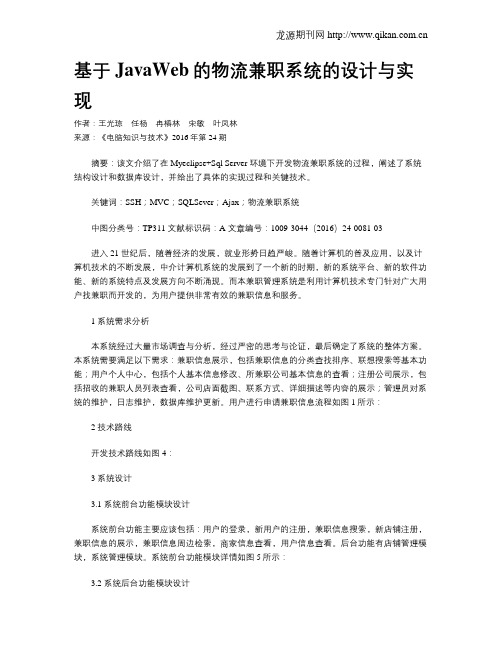
基于JavaWeb的物流兼职系统的设计与实现作者:王光琼任杨冉椿林宋敏叶凤林来源:《电脑知识与技术》2016年第24期摘要:该文介绍了在Myeclipse+Sql Server 环境下开发物流兼职系统的过程,阐述了系统结构设计和数据库设计,并给出了具体的实现过程和关键技术。
关键词:SSH;MVC;SQLSever;Ajax;物流兼职系统中图分类号:TP311 文献标识码:A 文章编号:1009-3044(2016)24-0081-03进入 21 世纪后,随着经济的发展,就业形势日趋严峻。
随着计算机的普及应用,以及计算机技术的不断发展,中介计算机系统的发展到了一个新的时期,新的系统平台、新的软件功能、新的系统特点及发展方向不断涌现。
而本兼职管理系统是利用计算机技术专门针对广大用户找兼职而开发的,为用户提供非常有效的兼职信息和服务。
1 系统需求分析本系统经过大量市场调查与分析,经过严密的思考与论证,最后确定了系统的整体方案。
本系统需要满足以下需求:兼职信息展示,包括兼职信息的分类查找排序、联想搜索等基本功能;用户个人中心,包括个人基本信息修改、所兼职公司基本信息的查看;注册公司展示,包括招收的兼职人员列表查看,公司店面截图、联系方式、详细描述等内容的展示;管理员对系统的维护,日志维护,数据库维护更新。
用户进行申请兼职信息流程如图1所示:2 技术路线开发技术路线如图4:3 系统设计3.1 系统前台功能模块设计系统前台功能主要应该包括:用户的登录,新用户的注册,兼职信息搜索,新店铺注册,兼职信息的展示,兼职信息周边检索,商家信息查看,用户信息查看。
后台功能有店铺管理模块,系统管理模块。
系统前台功能模块详情如图5所示:3.2 系统后台功能模块设计系统后台的定位为管理员使用,其基本功能为用户申请处理、店铺申请处理、兼职信息管理、用户管理、店铺管理等。
详情如图6所示:4 数据库设计本系统使用的数据库是Sql Server 2008数据库,系统数据库名称为LPT,数据库LPT中所包含的最主要的几张数据表及其关系如图7所示:5 关键技术5.1 API接口百度地图是百度提供的一项网络地图搜索服务,覆盖了国内近400个城市,数千个个区县,它提供了丰富的公交换乘,驾车导航的查询功能,提供丰富的路线规划。
基于大数据的智能物流管理系统设计与实现

基于大数据的智能物流管理系统设计与实现随着物流业的发展和互联网技术的普及,企业对物流运营的效率要求不断提高,传统的物流管理方式已经无法满足企业的需求。
而大数据技术的兴起,为物流运营的智能化提供了新的解决方案。
本文将重点介绍一种基于大数据的智能物流管理系统的设计与实现。
一、系统架构设计该系统采用C/S架构,客户端通过Web浏览器访问服务端,服务端进行数据处理和管理。
系统主要由以下模块组成:1. 数据采集模块:通过物联网技术将各种物流运营数据采集下来,包括运输车辆的位置、行驶速度、燃油消耗等信息。
2. 数据存储模块:将采集到的数据存储在关系型数据库中,并提供数据查询和统计分析功能。
3. 数据分析模块:对采集的数据进行分析,提取有价值的信息,为运营管理提供决策依据。
4. 业务管理模块:提供物流运营的核心功能,包括订单管理、车辆调度、货物跟踪、费用结算等。
5. 信息发布模块:向客户端推送最新的物流信息和运营报告。
二、数据采集与存储数据采集是智能物流系统的基础,系统需要采集的数据包括运输车辆的位置、行驶速度、燃油消耗等信息。
为了方便数据采集和管理,我们选择了传感器设备和云平台的组合方案。
通过在运输车辆上安装传感器设备,实时采集车辆的运行数据,并将数据上传至云平台。
在云平台上采用关系型数据库存储数据,方便日后的数据查询和分析。
三、数据分析与挖掘系统采集的数据是海量的、复杂的、多维度的数据,如何对数据进行分析和挖掘,从中提取有用的信息,是智能物流系统成功的关键。
以下是数据分析的几个方面:1. 路线规划与优化:通过分析车辆的行驶轨迹,对运输路线进行规划和优化,减少运输成本,提高运输效率。
2. 车辆监控与预测:通过对车辆的位置、速度、燃油消耗等数据进行分析,对车辆的状态进行监控和预测,提高车辆的安全性和可靠性。
3. 库存管理与预测:通过对货物的进出库数据进行分析,预测未来的货物需求量和库存需求,避免库存过剩或缺货现象。
- 1、下载文档前请自行甄别文档内容的完整性,平台不提供额外的编辑、内容补充、找答案等附加服务。
- 2、"仅部分预览"的文档,不可在线预览部分如存在完整性等问题,可反馈申请退款(可完整预览的文档不适用该条件!)。
- 3、如文档侵犯您的权益,请联系客服反馈,我们会尽快为您处理(人工客服工作时间:9:00-18:30)。
基于Java的物流管理系统设计与实现
摘要:随着世界经济的飞速发展,电商行业的成熟,使得物流行业逐渐变成人们关注的经济热点。
中国与物流相关的年总支出有139000亿元,物流成本占总GDP的20%-25%,不可否认物流行业的发展潜力一步步的展现了出来。
此次的物流公司订单管理系统是应用于现代物流公司业务设计的,用于提高公司工作效率,主要包括:客户信息管理、物流信息管理、客户订单管理与货物配送管理。
相比传统的物流管理方式如手工录入,核查物流信息的方式,本系统节省了人力物力的提高了物流运输的效率,实现了物流配送的流程智能化,简单化。
不仅为物流公司的客户带来便利,企业的效率得到提升。
关键词:物流管理、管理系统、JSP、B/S结构。
Abstract:As the rapid development of the world economy and the maturity of the e-commerce industry, The logistics industry has gradually become an economic hot spot. China's total annual expenditure related to logistics is 139 billion yuan and the cost of logistics accounts for 20 % - 25 % of the total GDP. There is no denying that the development potential of the logistics industry is showing step by step. This order management system of logistics company is applied to the business design of modern logistics company to improve the work efficiency of the company, mainly including customer information management, logistics information management, customer order management and goods distribution management. Compared with traditional logistics management methods such as manual entry and checking of logistics information, this system saves manpower and material resources, improves the efficiency of logistics transportation and realizes the intellectualization and simplification of logistics distribution process. It not only brings convenience to the customers of the logistics company, but also improves the efficiency of the enterprise.
Key words: Logistics ,Management systems, JSP, B / S structure.
目录
摘要 (I)
Abstract (I)
目录 (II)
1 绪论 (1)
1.1 研究背景 (1)
1.2 研究目的与意义 (1)
1.3 开发工具介绍 (2)
2 需求分析 (4)
2.1 需求考察 (4)
2.2 可行性分析 (4)
2.2.1 技术的可行性 (4)
2.2.2 经济的可行性 (5)
2.2.3 操作可行性 (5)
2.2.4 法律的可行性 (5)
2.3 系统用户用例图 (5)
2.4 功能模块需求分析 (7)
2.4.1实现功能 (7)
2.4.2 功能详解 (8)
2.5 性能需求 (9)
2.5.1 系统的安全性 (9)
2.5.2 数据的完整性 (9)
2.6 界面需求 (9)
3 系统分析与设计 (10)
3.1 数据库的分析与设计 (10)
3.1.2 数据库的逻辑结构设计 (10)
3.2 数据分析 (10)
3.3.1 数据库的E-R图设计 (11)
3.3.2 数据表的设计 (12)
3.4 数据库的连接 (13)
3.5 处理乱码问题 (14)
4 系统功能实现 (16)
4.1 系统的主界面设计 (16)
4.2 管理员功能模块的设计与实现 (17)
4.3 系统管理的设计与实现 (18)
4.4 订单管理的设计与实现 (18)
4.5 物流管理的设计与实现 (19)
5 测试 (19)
5.1 安全性测试 (21)
5.2 兼容性测试 (22)
6 结论 (23)
1 绪论
1.1 研究背景
在社会经济不断发展的大环境下,第三产业已经成为衡量一个国家的国家或地区生产社会化程度和市场经济发展水平的重要标志 [1]。
第三产业是指服务业,包括物流行业。
所以大力发展物流行业是优化经济结构结构,提高我国经济整体的必经之途,是实现现代化建设的必然要求。
就企业而言,如今的市场不再是以往的卖方市场,而是在逐渐向买方市场演变,所以要想拓宽自己的市场范围就需要不断的去改善自己的服务来提高客户的满意度。
社会经济的发展和市场的不断完善你向买家提供了更多的选择。
影响消费者的购买因素也由以往价格和质量拓展到“服务”上来。
要在激烈的市场竞争脱颖而出就必须从这些影响消费者满意度的因素中着手提高企业的竞争力。
所以“服务”已经成为现代企业赢得更多市场重中之重。
换而言之,在同等水平质量和水平的条件下,提供更好服务的企业也就能赢得更多市场。
物流运输业也属于服务业,物流运输业能有效地促进地区的经济发展。
物流运输包括的主要两大类分别为运输作业和运输设施。
其中运输硬技术主基础基础设施如铁路,公路,海运,运输车要等设备。
软技术是指管理方法,物流技术等。
区域物流就是以大城市为中心在与区域经济规模相适应的条件下[2],结合该区域的物流基础设施选择出最优的运输方式对货物进行流动。
以此来加强区域产品的流动,扩大物流的规模,从而增强该区域的经济综合实力。
构建物流运输系统就是为了达到区域物流所要达到的目的。
1.2 研究目的与意义
进行物流管理是为了用尽可能低的成本达到客户所要求的服务水平,需要做的就是不断的强化自身的服务优势和成本优势,从而创造企业竞争优势。
简单的来说,物流管理的基本目标就是实现适合的产品以合理的运输方式以恰倒其份的价格并且在合适的地点提供给有需求的客户。
物流电子平台的逐渐普及使得传统的物流配送方式如手工下单、手工核查大
大减少。
在节省了人力物力的同时提高了物流运输的效率,实现了物流配送的流程智能化,简单化。
随着经济的发展,交通运输量的持续增长,出现智能交通运输系统。
我国的科研人员是从上世纪70年代就结合了电子信息技术和交通运输进行研究和探索。
先是对国外一些项目的经验的消化吸取,相应出现一些智能运输系统的基础项目。
在上世纪80年代至90年代,高速公路收费系统,公路监控系统等在一些大城市被应用。
上世纪90年代以来,我国智能交通运输研究部门对交通信息网络建设加强了重视。
科研团队和工程团队的多年的研究努力,不仅在智能交通运输领域取得很多成果同时还为日后的智能运输发展奠定了深厚的基础。
但由于之前的研究多是针对一个板块进行的研究和探索,且研究水平有限导致项目没有很好的全局性和战略性,智能交通运输系统包括完善城市交通管理系统,发展公共交通系统,快速运货系统等[3]。
由于智能交通运输系统涉及到的领域十分宽阔,具有很强的综合性。
研究项目是从多方位技术,多角度进行的。
这意味这智能交通运输的发展将打破传统的僵局,将那些之前不相干的交通运输系统进行了合理组合。
因此智能交通运输系统的形成对公共交通运输的各个方面进行了协调管理,使得公路交通的建设、管理、运行的效率得到显著提升。
1.3 开发工具介绍
本系统采用Java语言在MyEclipse环境进行开发出的一个基于Web技术的B/S 结构的物流公司订单管理系统。
前台语言:JSP、HTML5。
后台服务器:MyEclipse、Tomcat、Sqlserver。
下面是对JSP、HTML5、MyEclipse、Tomcat、Sqlserver的简单介绍。
(1)MyEclipse
MyEclipse,本身是一个集成的开发环境,可以在它的基础上安装Java插件,C/C++插件、PHP插件。
可以轻松满足以Java编程语言的编程者。
采用Myeclipse 进行开发不仅是由于其功能强大,而且对开源产品的支持相当广泛,如支持Servlet,AJAX,JSP,JDBC数据库连接等等,十分便利。
